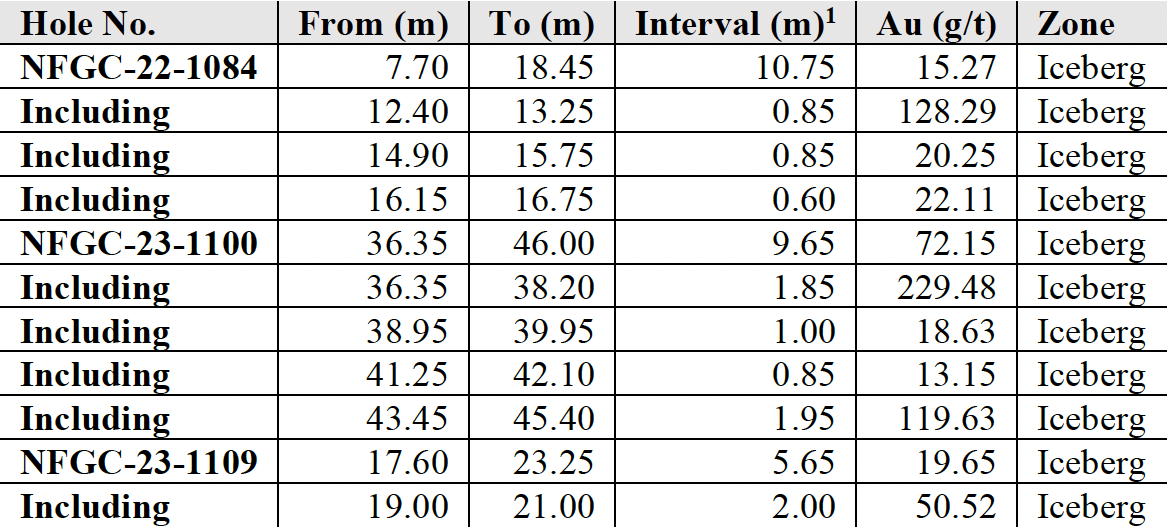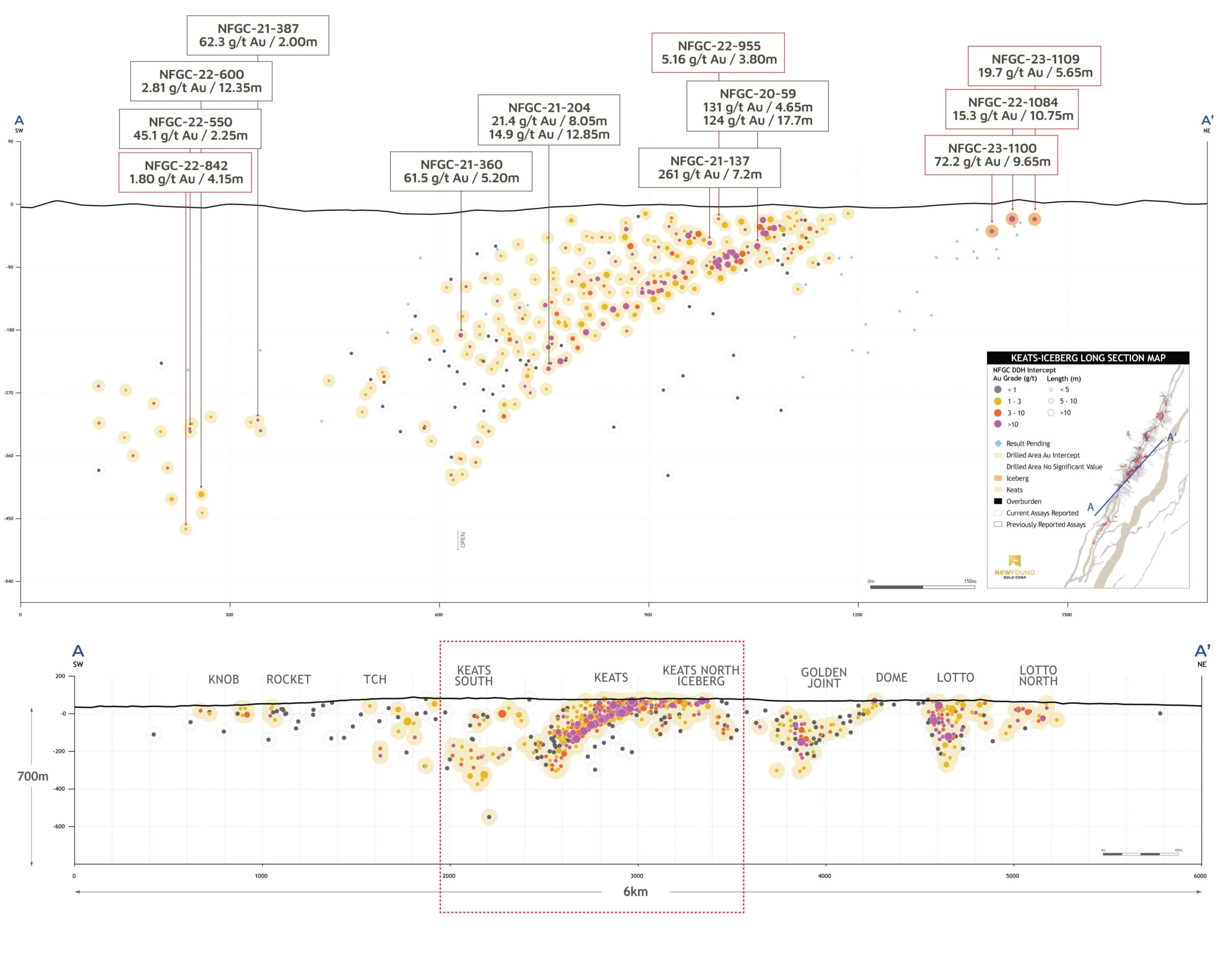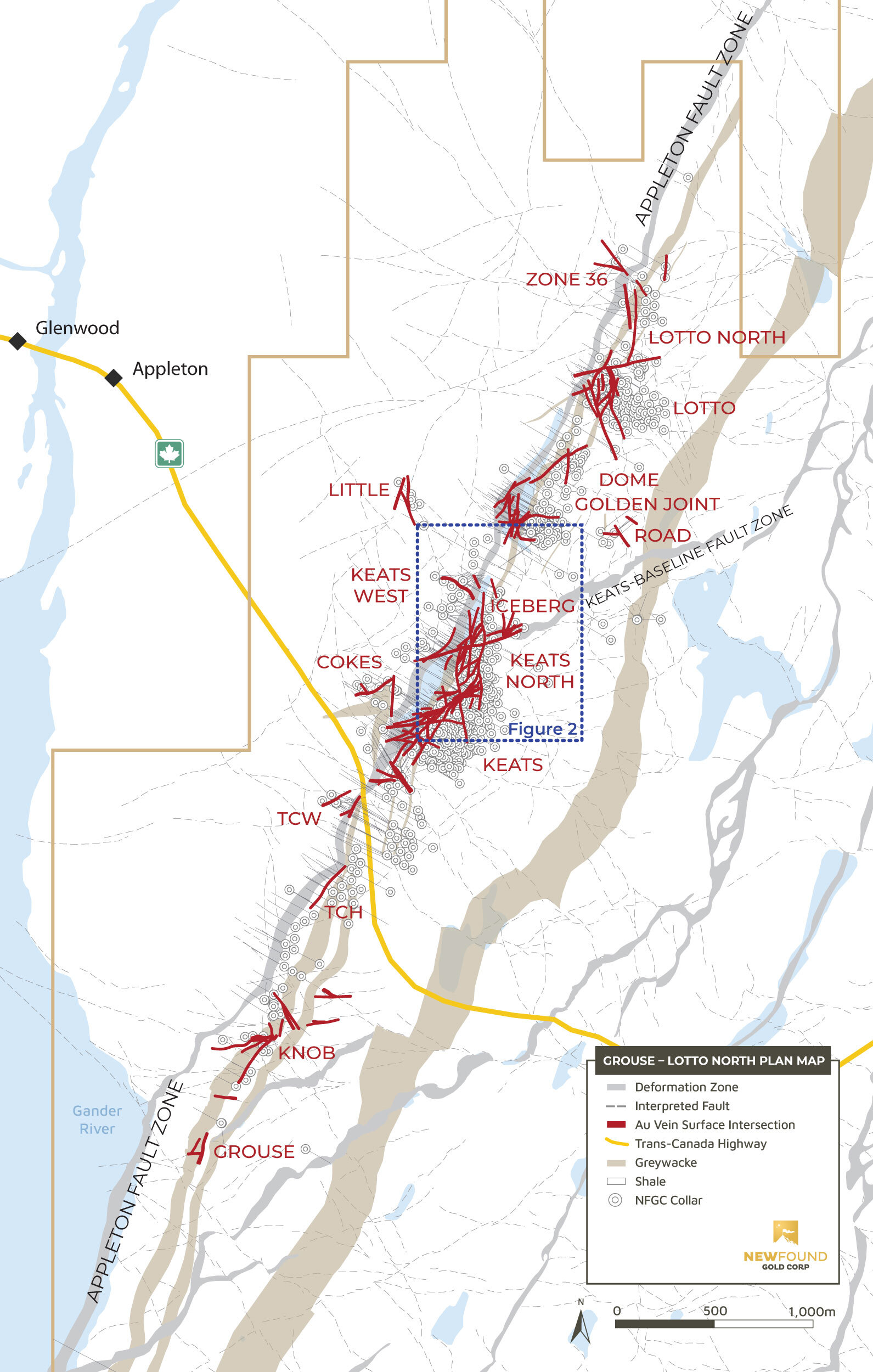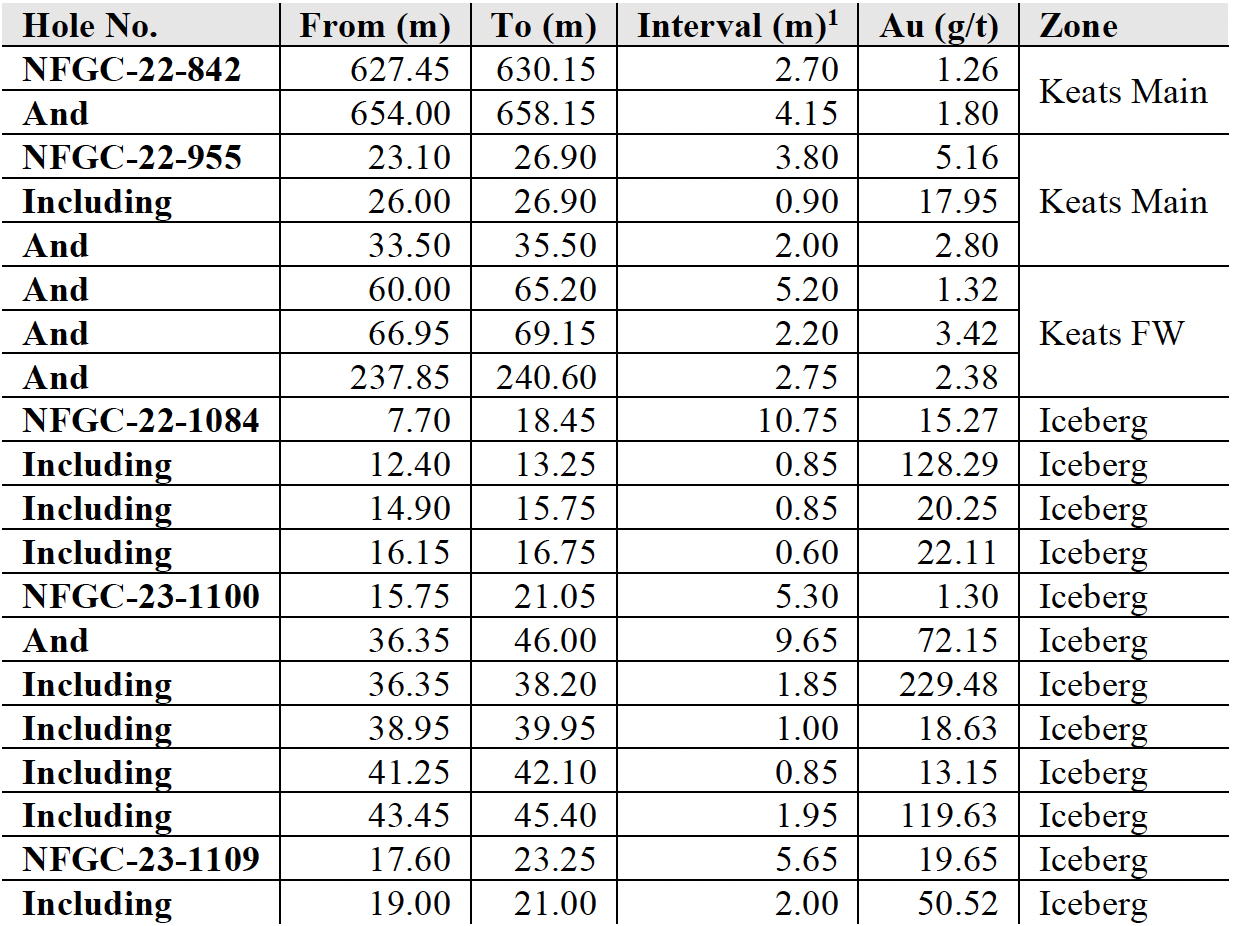Palisades Announces High-Grade Gold Zone Discovery by New Found Gold, Intercepting 72.2 g/t Au Over 9.65m
Vancouver, British Columbia, March 1, 2023 – Palisades Goldcorp Ltd. (TSX-V: PALI) (“Palisades” or the “Company”) today announced that New Found Gold Corp. (“New Found”), a significant equity investee of Palisades within the meaning of applicable Canadian securities legislation, has announced the discovery of Iceberg, a high-grade zone located 300m northeast of Keats Main along the highly prospective Appleton Fault Zone (“AFZ”). New Found’s 100%-owned Queensway project comprises a 1,650km2 area, accessible via the Trans-Canada Highway, 15km west of Gander, Newfoundland and Labrador.
Iceberg Highlights:

1Note that the host structures are interpreted to be steeply dipping and true widths are generally estimated to be 60% to 95% of reported intervals. Infill veining in secondary structures with multiple orientations crosscutting the primary host structures are commonly observed in drill core which could result in additional uncertainty in true width. Composite intervals reported carry a minimum weighted average of 1 g/t Au diluted over a minimum core length of 2m with a maximum of 2m consecutive dilution. Included high-grade intercepts are reported as any consecutive interval with grades greater than 10 g/t Au. Grades have not been capped in the averaging and intervals are reported as drill thickness.
- Today’s holes outline a new high-grade, at surface discovery named Iceberg that spans a strike length of 50m and remains open in all directions and to depth. Drilling collared into mineralization in NFGC-22-1084 with 15.3 g/t Au over 10.75m, while a 25m step-out south intersected 72.2 g/t Au over 9.65m in NFGC-23-1100, and a 25m step-out north intersected 19.7 g/t Au over 5.65m in NFGC-23-1109. All three intercepts are shallow, occurring at depths of less than 30m from surface (Figures 1-4).
- Iceberg is found along the highly prolific Keats-Baseline Fault Zone (“KBFZ”), the structure that is host to the Keats Main Zone. Iceberg shares a similar orientation to Keats Main and is comprised of a multitude of intersecting veins concentrating high-grade gold mineralization. Geological characteristics of Iceberg are nearly identical to those observed at Keats Main and the Company’s current interpretation is that Iceberg is the eastern continuation of Keats Main that has been displaced by faulting.
- As a result of this new interpretation, additional drills have been mobilized to this area to aggressively explore the along strike potential of the KBFZ. Several holes at Iceberg are pending assay.
Greg Matheson, COO of New Found, stated: “The discovery of Iceberg renews our enthusiasm around the highly prolific KBFZ. Iceberg exudes the same qualities that our earlier drilling found at Keats Main. Both display significant quartz veining over several-metre-wide intercepts that start at surface and both are hosted by the KBFZ – a fault with demonstrated ability to concentrate significant amounts of high-grade gold mineralization with considerable strike continuity. The KBFZ is an extensive structure and it has proven once again that it has more to offer. Following the mantra to ‘explore by keeping one foot in mineralization’, we have beefed up our exploration efforts at Iceberg to expand upon the high-grade intercepts reported today and to seek additional near-surface mineralization along strike.
“It is worth noting that this discovery was made by New Found’s geologic team as a result of prediction-based modelling, with the team theorizing a potential faulting off at Keats Main. This is in itself an exciting development as it displays a growing understanding of what is no doubt a complex gold system.”

^Note that these photos are not intended to be representative of gold mineralization in NFGC-23-1109 and NFGC-23-1100.



Drillhole Details

1Note that the host structures are interpreted to be steeply dipping and true widths are generally estimated to be 60% to 95% of reported intervals. Infill veining in secondary structures with multiple orientations crosscutting the primary host structures are commonly observed in drill core which could result in additional uncertainty in true width. Composite intervals reported carry a minimum weighted average of 1 g/t Au diluted over a minimum core length of 2m with a maximum of 2m consecutive dilution. Included high-grade intercepts are reported as any consecutive interval with grades greater than 10 g/t Au. Grades have not been capped in the averaging and intervals are reported as drill thickness.

Queensway 500,000m Drill Program Update
New Found is currently undertaking a 500,000m drill program at Queensway. Approximately 51,500m of core is currently pending assay results.
Sampling, Sub-sampling, and Laboratory
True widths of the intercepts reported in this press release have yet to be determined but are estimated to be 60% to 95% of reported core lengths. Infill veining in secondary structures with multiple orientations crosscutting the primary host structures are commonly observed in drill core which could result in additional variability in true width. Assays are uncut, and composite intervals are calculated using a minimum weighted average of 1 g/t Au diluted over a minimum core length of 2m with a maximum of 2m consecutive dilution. Included high-grade intercepts are reported as any consecutive interval with grades greater than 10 g/t Au.
All drilling recovers HQ core. Drill core is split in half using a diamond saw or a hydraulic splitter for rare intersections with incompetent core.
A geologist examines the drill core and marks out the intervals to be sampled and the cutting line. Sample lengths are mostly 1.0 metre and adjusted to respect lithological and/or mineralogical contacts and isolate narrow (<1.0m) veins or other structures that may yield higher grades.
Technicians saw the core along the defined cutting line. One-half of the core is kept as a witness sample and the other half is submitted for analysis. Individual sample bags are sealed and placed into totes, sealed and marked with the contents.
New Found submits samples for gold determination by fire assay to ALS Canada Ltd. (“ALS”) and by photon assay to MSALABS (“MSA”) since June 2022. ALS and MSA operate under a commercial contract with New Found.
Drill core samples are shipped to ALS for sample preparation in Sudbury, Ontario, Thunder Bay, Ontario, or Moncton, New Brunswick. ALS is an ISO-17025 accredited laboratory for the fire assay method.
Drill core samples are also submitted to MSA in Val-d’Or, Quebec. MSA operates numerous laboratories worldwide and maintains ISO-17025 accreditation for many metal determination methods. Accreditation of the photon assay method at the MSA Val D’Or laboratory is in progress.
At ALS, the entire sample is crushed to approximately 70% passing 2mm. A 3,000-g split is pulverized. “Routine” samples do not have visible gold (VG) identified and are not within a mineralized zone. Routine samples are assayed for gold by 30-g fire assay with an inductively-couple plasma spectrometry (ICP) finish. If the initial 30-g fire assay gold result is over 1 g/t, the remainder of the 3,000-g split is screened at 106 microns for screened metallics assay. For the screened metallics assay, the entire coarse fraction (sized greater than 106 microns) is fire assayed and two splits of the fine fraction (sized less than 106 microns) are fire assayed. The three assays are combined on a weight-averaged basis. Samples that have VG identified or fall within a mineralized interval are automatically submitted for screened metallic assay for gold.
At MSA, the entire sample is crushed to approximately 70% passing 2mm. For “routine” samples that do not have VG identified and are not within a mineralized zone, the samples are riffle split to fill two 450g jars for photon assay. The assays reported from both jars are combined on a weight-averaged basis. If one of the jars assays greater than 1 g/t, the remaining crushed material is weighed into multiple jars and are submitted for photon assay.
For samples that have VG identified or are within a mineralized zone, the entire crushed sample is weighed into multiple jars and are submitted for photon assay. The assays from all jars are combined on a weight-averaged basis.
All samples prepared at ALS or MSA are also analyzed for a multi-element ICP package (ALS method code ME-ICP61) at ALS Vancouver.
Drill program design, Quality Assurance/Quality Control and interpretation of results are performed by qualified persons employing a rigorous Quality Assurance/Quality Control program consistent with industry best practices. Standards and blanks account for a minimum of 10% of the samples in addition to the laboratory’s internal quality assurance programs.
Quality Control data are evaluated on receipt from the laboratories for failures. Appropriate action is taken if assay results for standards and blanks fall outside allowed tolerances. All results stated have passed New Found’s quality control protocols.
New Found’s quality control program also includes submission of the second half of the core for approximately 5% of the drilled intervals. In addition, approximately 1% of sample pulps for mineralized samples are submitted for re-analysis to a second ISO-accredited laboratory for check assays.
The Company does not recognize any factors of drilling, sampling or recovery that could materially affect the accuracy or reliability of the assay data disclosed.
The assay data disclosed in this news release were verified by New Found’s Qualified Person against the original assay certificates.
New Found notes that it has not completed any economic evaluations of its Queensway Project and that the Queensway Project does not have any resources or reserves.
Qualified Person
The scientific and technical information disclosed in the press release issued by New Found – and duplicated in its entirety above – was reviewed and approved by Greg Matheson, P. Geo., Chief Operating Officer of New Found and a Qualified Person as defined under National Instrument 43-101.
About Palisades Goldcorp Ltd.
Palisades Goldcorp Ltd. is a resource investment company focused on junior companies in the resource and mining sector. The Company seeks to acquire equity participation in pre-initial public offering and early stage public resource companies with undeveloped or undervalued high quality projects. The Company focuses on companies that are in need of financial resources to realize their full potential, are undervalued in capital markets and/or operate in jurisdictions with low to moderate local political risk. The Company expects to continue to make investments, pursuant to its dual investment strategy, to achieve broad sector exposure with upside in the event of appreciation in mineral commodities prices, while also providing the potential to realize appreciation in net asset values as a result of discoveries by issuers in which the Company holds larger positions. The Company is listed on the TSX Venture Exchange under the stock symbol “PALI”. Palisades holds a diverse portfolio of securities and derivatives, among which it holds a 26.67% interest in New Found Gold Corp. (TSX-V: NFG).
On behalf of the Board of Directors
“Collin Kettell”
Collin Kettell
Chief Executive Officer and Director
Phone: +1 (845) 535-1486
Email: collin@palisades.ca
Neither the TSX Venture Exchange nor its Regulation Services Provider (as that term is defined in the policies of the TSX Venture Exchange) has reviewed or accepts responsibility for the adequacy or accuracy of this release.
Cautionary Note Regarding Forward-Looking Statements:
This news release contains “forward-looking information” within the meaning of applicable Canadian securities legislation (collectively, the “forward-looking statements”). Forward-looking statements are statements that are not historical facts; they are generally, but not always, identified by the words “will”, “can”, “may”, “could”, “expects”, “plans”, “anticipates” and similar expressions which, by their nature, refer to future events. Forward-looking statements included herein include, but are not limited to, statements with respect to exploration, drilling and mineralization on New Found’s Queensway gold project in Newfoundland and Labrador; assay results; the interpretation of drilling and assay results, the results of the drilling program, mineralization and the discovery of zones of high-grade gold mineralization; plans for future exploration and drilling and the timing of same; and the merits of the Queensway project.Although the Company believes that such statements are reasonable, it can give no assurance that such expectations will prove to be correct. The Company cautions that forward-looking statements are based on the beliefs, assumptions, estimates and opinions of the Company’s management on the date the statements are made. Consequently, there can be no assurances that such statements will prove to be accurate and actual results and future events could differ materially from those anticipated in such statements. With respect to New Found and Palisades investment therein, factors that could cause future results to differ materially from those anticipated in these forward-looking statements include risks associated with possible accidents and other risks associated with mineral exploration operations, the risk that New Found will encounter unanticipated geological factors, risks associated with the interpretation of assay results and the drilling program, the possibility that New Found may not be able to secure permitting and other governmental clearances necessary to carry out its exploration plans, the risk that New Found will not be able to raise sufficient funds to carry out its business plans, and the risk of political uncertainties and regulatory or legal changes that might interfere with business and prospects. The reader is urged to refer to the Company’s continuous disclosure documents publicly available through the Canadian Securities Administrators’ System for Electronic Document Analysis and Retrieval (SEDAR) at www.sedar.com for a more complete discussion of such risk factors and their potential effects. Except to the extent required by applicable securities laws and the policies of the TSX Venture Exchange, the Company undertakes no obligation to update these forward-looking statements if management’s beliefs, estimates or opinions, or other factors, should change.